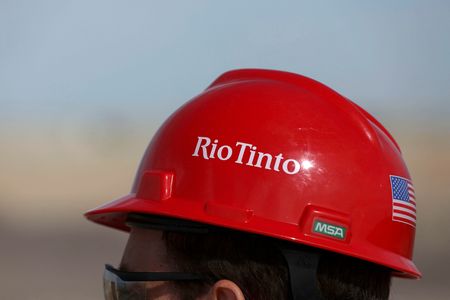By Clara Denina and Harish Sridharan
LONDON (Reuters) -Rio Tinto more than halved its dividend on Wednesday after posting a 38% drop in annual profit, hurt by weaker iron ore prices as demand from China slowed, higher labour and material costs.
The Anglo-Australian miner joins other diversified mining companies in reporting lower earnings and shareholder payouts from the record levels reported in 2022, after disruptions lowered output and costs rose for energy, skilled labour, explosives and equipment.
Rio reported underlying earnings of $13.3 billion for 2022, compared with a record $21.4 billion in 2021, missing a Refinitiv estimate of $13.8 billion. It declared a full-year dividend of $4.92 per share, down from 2021’s record payout of $10.40 per share.
Its shares were down 2.2% at 0817 GMT.
Strict COVID-19 curbs in top steel producer China curtailed economic activity last year, dragging down iron ore prices from lofty levels a year earlier.
But the world’s top iron ore producer said Chinese consumption showed signs of rebounding.
“It is very positive that China now also comes out of COVID lockdowns … and we are quietly confident that (China’s) demand will be a stabilising factor for the world economy in 2023,” Chief Executive Jakob Stausholm told reporters.
China, the world’s second-biggest economy, in January re-opened its borders and eased quarantine requirements for travellers after three years of tight controls, and is putting in place policies to boost its sagging economy.
Rio Tinto lowered its capital investments guidance for 2023 to $8 billion from $8-9 billion, while raising its estimates for 2024 and 2025 to $9-10 billion.
The estimates include around $3 billion a year for growth capital, said Chief Financial Officer Peter Cunningham, as the miner moves to ramp up projects, including Guinea’s vast iron ore deposit Simandou, Argentina’s lithium asset Rincon and the underground expansion of its massive Oyu Tolgoi copper and gold mine in Mongolia.
On Tuesday, rival BHP Group reported a steeper-than-expected 32% fall in first-half profit but also flagged a brightening outlook in China.
Rio Tinto last year earned an average realised price of just $106.10 per dry metric tonne (dmt) of iron ore, down from $143.80 per dmt in 2021.
It maintained its production and unit cost guidance for 2023.
Additional investments to ramp up production at the Gudai-Darri mine in Pilbara, Australia, along with higher diesel prices and labour costs, resulted in Pilbara unit cash costs rising to $21.30 per tonne in 2022, Rio said.
“Similar to the rest of the industry, compressing margins and rising capex will place pressure on free cash flow generation,” RBC Capital Markets analysts said.
GROWTH DILEMMA
Despite the vast volumes of copper, lithium, nickel and cobalt needed for the transition to a lower carbon economy, major mining companies have limited plans to develop mines that take several years to turn a profit.
Some have preferred to grow through acquisitions, with BHP making a $6.5 billion cash offer for copper and gold producer OZ Minerals.
Others are investing in projects belonging to smaller developers.
Rio last year suffered a setback to its ambition to become a significant lithium producer, when the Serbian government revoked licences for its Jadar project after massive protests sparked by environmental concerns over the planned mine.
“We have a lot going on, mostly are organic opportunities, except Rincon which was our first acquisition for a decade and then followed that by taking TRQ private,” Stausholm said.
“So we look at it asset by asset – would we like to grow in lithium? Yes. On the other hand, it’s very expensive right now.”
“I’m not looking at big transformative M&A changes at the moment. We are on a very important transformative journey and I don’t want it to be disturbed by too big M&A.”
(Reporting by Clara Denina, Harish Sridharan, Harshita Swaminathan; Editing by Subhranshu Sahu, Sonali Paul and Mark Potter)

